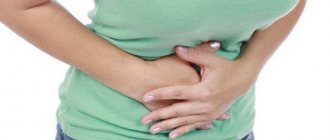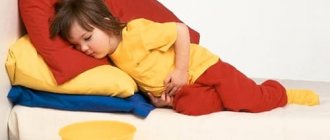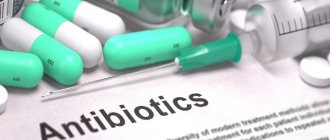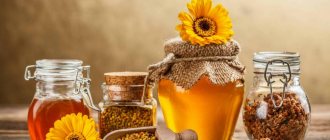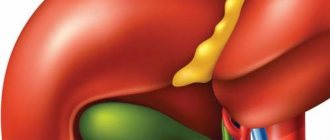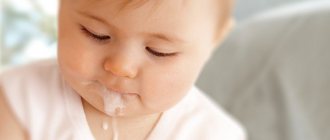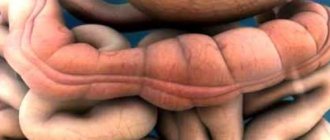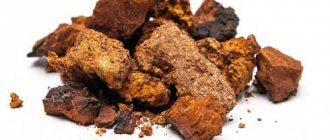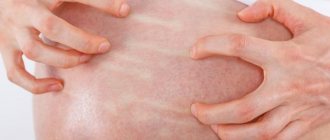Poisoning by household poisons in a child
Poisoning in children is a common occurrence. The development of pathology is facilitated by the entry of foreign substances or microorganisms (bacteria, fungi) into the body. Poisoning in children is caused by microbes, their toxins, inedible fruits and berries, water contaminated with bacteria and chemicals, medications, vitamins, pesticides, nitrates (may be contained in early vegetables and fruits), and heavy metals. Delayed and improper treatment of sick children can lead to serious consequences.
Classification of food poisoning in children
There are 3 types of food poisoning of microbial etiology:
- Toxic infections. The development of the disease is associated with the entry of bacteria into the body in large quantities. Food products are a favorable environment for the proliferation of microbes. A risk factor for the development of toxic infection in a child is eating low-quality, unwashed and expired foods. Their contamination is possible through hands, dirty dishes, boards and cutlery. Bacteria can be carried by flies and cockroaches.
- Intoxication (toxicosis). The group includes botulism and staphylococcal toxicosis. Symptoms occur when not the microbes themselves enter the body, but an exotoxin, which can accumulate in products if sanitary and hygienic conditions are not observed and food is not stored properly. Toxicosis in children most often develops from consuming confectionery products, dairy products, salads, ice cream and canned food (botulism).
- Mixed (caused by microbes and their toxins).
A separate group of poisonings caused by the ingestion of fungal toxins into the body with food (mycotoxicosis) has been identified. These include ergotism and fusariotoxicosis. A risk factor is eating grains and legumes affected by fungi.
Watermelon as a source of nitrates
Non-microbial food poisoning occurs due to accidental consumption of toxic substances. Toxins are found in animal meat (some types of fish, arthropods), mushrooms, berries and plants. In early summer, poisoning with nitrates is often diagnosed, which are used in large quantities in the form of fertilizers to speed up the ripening of vegetables and fruits. Poisoning of watermelons, melons, zucchini and eggplants has been observed. Intoxication of children with solanine, which is contained in green, rotten and sprouted potatoes, is possible.
Procedure
What to do at home if your child shows signs of poisoning? Remember that first aid at home can only be provided if the child is over 3 years old. If the child is younger, it is strictly forbidden to treat him on his own—consultation with a specialist is required.
With vomiting and diarrhea, the body is freed from toxic substances, but at the same time it loses a large amount of fluid. Therefore, the first thing to do to prevent dehydration is to immediately begin to restore your water balance. It is necessary to give the child 1–2 tablespoons of Regidron solution every 10–15 minutes. Or prepare the solution yourself. To do this you will need:
- 1 liter of boiled water;
- 2 tablespoons sugar;
- 1 teaspoon salt;
- 1 teaspoon of soda.
Mix thoroughly and drink frequently, in small quantities.
To remove toxins from the body, you need to give sorbent drugs: activated carbon, Smecta, Enterosgel. The dosage of medications must be strictly observed taking into account the age and weight of the baby.
When the vomiting stops, you should give a probiotic - a drug containing microorganisms beneficial to humans that normalize and maintain the proper functioning of the gastrointestinal tract. These are Linex, Bifiform Malysh or Acipol.
When treating poisoning, it is important to drink as much fluid as possible and stick to your diet. It is recommended to drink weak tea and eat liquid food only after the vomiting has stopped. What you can eat:
- puree soup without meat;
- low-fat fermented milk products;
- vegetable broth;
- porridge on water.
Read also Enterosgel: instructions for use for vomiting in children
What to avoid:
- fresh bread;
- fried and spicy foods;
- fat meat;
- milk;
- juice;
- raw vegetables and fruits;
- eggs;
- sweets.
Why are food poisoning more serious in children than in adults?
A more severe course of poisoning in childhood is due to:
- Unformed immune system.
- Higher pH of gastric juice (less acidity).
- Different microbial composition of the intestines.
- Accelerated absorption of toxic compounds into the bloodstream.
- Insufficient detoxification function of the liver.
- Lower glomerular filtration rate. The indicator is necessary for the purification of blood plasma and the elimination of toxic substances in the urine.
Children require fewer germs and toxins to show symptoms of poisoning compared to adults.
How to identify symptoms of poisoning
Symptoms of intoxication in a child can be different, as a rule, each symptom indicates a specific infection. The most common is food poisoning. There are very rare cases when poisoning occurs due to dangerous substances or through prolonged contact with them. Symptoms in children with such intoxication are much stronger and more noticeable than in adults.
Clinical manifestations
Common signs of food poisoning:
- Vomiting of eaten food. May occur once or several times. Vomit has a sour odor and may contain undigested food fragments and bile. This is a protective reaction that allows you to cleanse the stomach of harmful substances.
- Frequent, loose (watery) stools mixed with mucus or streaked with blood. In severe forms of poisoning, the frequency of stool reaches 10 or more times per day. A lot of fluid is released with stool, which leads to dehydration (dehydration). Diarrhea in case of poisoning occurs due to the effect of enterotoxin on the body, which enhances the production of water and salts that retain fluid.
- Abdominal pain. In case of poisoning, it is felt in the projection of the stomach (epigastric region). Pain indicates gastritis or gastroenteritis.
- Nausea.
- Cramps. They arise as a result of loss of fluid and salts.
- Increase in body temperature to +38…+39 °C. The symptom is observed simultaneously with dyspeptic disorders. Hyperthermia is the body's response to infection.
- Headache. Caused by intoxication. The level of ketone bodies and urea in the blood increases.
- Pain in muscles and joints.
- Malaise.
- Tearfulness.
- Refusal of food.
- Bloating.
- Impaired consciousness (confusion, stupor, coma).
- Increased agitation.
- Sweating.
- Chills.
When toxins from poisonous plants enter the gastrointestinal tract, symptoms of damage to the central nervous system, visual disturbances, euphoria, speech impairment and hallucinations are observed. Convulsions are possible.
Poisoning of children with fly agaric mushrooms can manifest as severe weakness, vomiting, rare heartbeat, salivation, diarrhea-type bowel movements, delirium, drop in blood pressure and signs of bronchospasm (shortness of breath, coughing, wheezing).
Food poisoning of the botulism type is characterized by blurred vision, fog before the eyes, double vision (diplopia), strabismus, difficulty moving the eyeballs, dysphagia, dry mouth, voice changes, movement disorders, chest pain, shallow and rapid breathing, vomiting, diarrhea (at an early stage), pale skin and impaired facial expressions (occurs as a result of damage to the facial nerve).
Treatment
For intestinal poisoning
Parents, if you notice the first signs of poisoning in your child, the main thing is not to panic and take action ! You are required to provide your child with first aid. Treatment should begin at the first suspicion of intoxication.
First aid
Emergency care for poisoning through the gastrointestinal tract:
- Call an ambulance immediately! When you call the team, you may be connected to a poison control center, where you will be advised.
- Provide your baby with constant observation and a comfortable position until doctors arrive. If there is vomiting, sit or place the child on your lap, head down, and place a basin. If there is no consciousness, turn the baby onto his side. To prevent vomit from interfering with the child’s breathing, you can wrap your finger in a handkerchief and cleanse the mouth.
- Try to determine what the child was poisoned with. If the child is able to explain something, ask what he ate. Pay attention to possible odors, stains, redness or burns on the skin.
- Close monitoring of the baby and a clear description of all changes in his condition are necessary - this will help doctors quickly identify the causative agent of intoxication.
Gastric lavage
Gastric lavage is the first step in removing toxins, but treatment with this method can only be done on a newborn in a hospital or under the supervision of a doctor at home. Treating the stomach with lavage is effective only within a few hours after toxins enter the body.
Remember the contraindications:
- do not induce vomiting when the baby is unconscious;
- do not give carbonated drinks or mineral water;
- Do not rinse the stomach for burns of the larynx and gastrointestinal tract caused by poisoning with kerosene, gasoline, acid or alkali!
At home, you can cleanse your baby’s stomach with boiled water, the temperature of which should be 36-37C. Required amount of liquid by age categories of children:
- for a child over 1 year old – about 1 liter;
- in preschool age – 3-5 years;
- for a schoolchild – 6-7 years;
- for a teenager you need 8 liters. water.
The normal reaction of the stomach to heavy drinking is vomiting. This procedure should be done from 2 to 5 repetitions. If there is no vomiting, lavage should be carried out in a hospital setting using a nasogastric tube.
Activated carbon
Activated carbon is popular in use both for poisoning and for other gastrointestinal diseases. At home, activated carbon is an indispensable emergency aid for a child , since it is always available in the first aid kit.
Activated carbon is taken orally, and the tablet must be crushed for the baby and diluted with water. Activated carbon can be given to a child in proportion, depending on his weight: 0.05 g. medications/1kg body weight. Activated carbon should be taken 3 times a day. The maximum dose of the drug is 0.2 mg/1 kg of weight. Treatment of children with sorbent lasts about 3-5 days.
Activated carbon is contraindicated to give to children with stomach or intestinal ulcers.
When taking this remedy, keep in mind that after drinking activated carbon, you need to take 2-hour breaks before eating, otherwise the treatment will not be effective. Activated charcoal can also stop diarrhea in children, as it removes excess fluid from the body.
Breasts can be given activated carbon in the form of granules, paste or powder form. More modern drugs have become popular, for example Enterosgel, Smecta, Sorbex. Smecta can also be given to your baby to relieve diarrhea and bloating.
Please note that activated carbon comes in different weights, so be sure to check the instructions.
Fighting dehydration
First aid for a child
If a child is poisoned, you must:
- Stopping the entry of toxins and microbes into the body. Achieved by refusing food.
- Cleansing the stomach of food debris. In case of food poisoning, gastric lavage is mandatory. Use clean water, a weak solution of potassium permanganate (potassium permanganate) or saline solution. For botulism, an alkaline solution is used to neutralize botulinum toxin. Colon cleansing is carried out until the rinsing waters become clear.
- Purgation. It is carried out using enemas.
- Rehydration. For mild dehydration, drinking plenty of fluids (sweet tea) and taking saline solutions orally are recommended. In severe cases, infusion therapy with saline agents is performed.
- Taking medications.
The main causes of natural and infectious food poisoning
Parents often neglect the simplest safety rules, which can lead to food poisoning.
Here are the most common actions that can make a child feel unwell:
- Ignoring shelf life of products. Don’t turn a blind eye to the fact that the glazed cheese curd expired 1-2 days ago. The same applies to fruits and vegetables that have begun to rot. Even by cutting off the damaged edge, microbes that have begun to develop can be introduced into the child’s body.
- Failure to comply with food storage rules. Even the freshest meat or sausage can send a baby to a hospital bed if they are not hidden in the refrigerator in a timely manner.
- Lack of proper heat treatment of products. Before giving your child a cutlet, you should make sure that it is thoroughly fried or steamed. Raw meat may contain harmful microorganisms. The same applies to eggs, fish, semi-finished products (including sausages) and other things.
Treatment and traditional medicine
If a child is poisoned after eating, the following medications may be prescribed:
- Electrolyte solutions (Trisol, Regidron).
- Enterosorbents. White and black activated carbon, Enterosgel, Smecta, Polysorb MP and Polyphepan are used. The dose is calculated based on the child's weight. The drugs are safe for children; they adsorb bacteria and toxic substances on the surface, removing them from the body naturally (with feces).
- Antispasmodics. No-Shpa is prescribed to children over 6 years of age (for tablets), and Drotaverine in tablet form is used from 3 years of age. Antispasmodics help eliminate pain.
- Drugs that eliminate flatulence (Espumizan). Prescribed for severe bloating.
- Antibiotics from the nitrofuran group (Furazolidone). Prescribed for symptoms of foodborne illness.
- Antipyretics (antipyretics). Indicated at high (more than +38…+38.5 °C) temperatures. Upsarin Upsa (from 15 years), Panadol (from 6 years), Ibuprofen, Efferalgan (from 12 years), Paracetamol and Aspirin (from 15 years) are used.
- Antiemetics (prokinetics). These include Metoclopramide, Perinorm, Domperidone and Cerucal.
- Medicines containing beneficial microorganisms (probiotics, eubiotics). Acylact (tablets), Bifiform (capsules), Bifidumbacterin, Linex (capsules) and Hilak Forte (drops) are used.
- Immunological preparations (antibotulinum serum in the form of an injection solution, immunoglobulin). Prescribed for botulism.
- Infusion agents (glucose solution, saline solution).
- Diuretics (Furosemide, Lasix). They are used during forced diuresis to increase the amount of urine and cleanse the blood of toxins.
- Gastroprotectors (De-Nol).
- Antacids (Gaviscon, Rennie, Almagel). Prescribed for acute gastritis due to poisoning.
- Antidiarrheals with antibacterial effect (Stopdiar). Tablets are used from 7 years of age. The use of Imodium and Loperamide is not recommended: the medications do not kill bacteria and retain stool; they can only be used as aids when it is necessary to contain bowel movements and get rid of diarrhea (during travel, while studying).
Folk remedies include rosehip infusion, raw potato juice, infusion of St. John's wort and chamomile, dill infusion with honey, marshmallow root and rice infusion.
Diet for food intoxication
In case of poisoning with mushrooms, animal products, plant foods, canned food and chemicals, you need to adhere to a gentle diet. Sick children need:
- Drink more. Required for symptoms of dehydration (cramps, dry skin, dry mouth, thirst, lethargy), frequent diarrhea and vomiting.
- Avoid hard, spicy, fried, smoked and raw foods. Cooked food should be ground, boiled, stewed or baked.
- Avoid eating fruits and raw vegetables (tomatoes, cucumbers, cabbage, radishes, radishes, legumes).
- Eliminate fatty meats, dairy products and fish from the menu.
- Do not drink coffee, black tea, sparkling water, do not eat sweets, fresh pastries and spices.
- Eat a little, but often (5-6 times a day).
In case of poisoning, children are advised to drink clean, boiled water, rosehip decoction, natural fruit drinks, non-carbonated mineral water, jelly and compotes. The menu includes mucous and vegetable soups, porridges, steamed cutlets, low-fat kefir, yoghurts and cereals. During the acute stage of poisoning, temporary abstinence from food is recommended.
Complications
Consequences of poisoning due to the consumption of raw and low-quality foods, chemicals and other substances:
The effect of botulinum toxin on the body
- dehydration of the body;
- damage to the heart, nervous system (with botulism), kidneys and liver;
- acute gastritis;
- acute gastroenteritis;
- gastrointestinal bleeding;
- shock;
- intestinal dysbiosis;
- aspiration of vomit with the development of pneumonia;
- rectal prolapse and anal fissures (with severe diarrhea);
- sepsis;
- hypovolemia (decreased circulating blood volume);
- pressure drop;
- convulsive syndrome;
- electrolyte disturbances;
- thrombosis.
